Task I
You should spend about 20 minutes on this task.
The graph shows the percentage of the population living in urban areas in different continents.
Summarise the information by selecting and reporting the main features, and make comparisons where relevant.
Write at least 150 words.
The graph illustrates the percentage of people in 5 continents living in cities in 2003 and a speculated figure is also given for 2030. In addition to the continents, a global average is also given in the category marked ‘World’.
In 2003, the most notable feature was that in Africa, fewer than 40% of the population resided in areas considered to be urban; the figure in Asia was slightly higher at approximately 45%. In contrast, the population for Europe and the Americas ranged from just over 70% to 80%, over 20% higher than the global average illustrated in the ‘world’ category.
By 2030, it is estimated that an increasing number of people will be living in cities, with South America being the highest with over four fifths of the population. In addition, the range between the continents is presented as being closer in the future than it was in the past.
Overall, the graph clearly illustrates a rising trend on a global scale towards living in cities, an increasing trend that is most notable in Africa and Asia.
(178 words)
Task 2
You should spend about 40 minutes on this task.
Write about the following topic:
Education is very important. How can children who are disinterested in study be motivated to learn?
Give reasons for your answer and include any relevant examples from your own knowledge or experience.
Write at least 250 words.
Starting as young as aged 5, students are often expected to maintain a desire to learn for upwards of 10 years. For some students, this inevitably leads to a lack of interest in education, as will now be discussed.
A primary reason why some students are not focused during class is the direct result of more traditional forms of teaching which lacks any real interactivity. More active participation by the student during classroom sessions will make the topic more engaging and subsequently motivates the participants to learn. Such interactivity can include field trips, student presentations and other students-driven learning.
There are also many different learning styles, and it would be unrealistic to expect all students to learn in the same manner. Certain subjects and pedagogical styles will suit some students better than others, so it is essential that a teacher vary their teaching style so as to interest the widest variety of students at least some part of each school day.
A final point is that the desire to learn is not simply an issue that should be addressed in schools. Like much of our behaviour, the influence of family, especially parents, is vital. By establishing an environment in which learning is considered positive, rather than simply a duty or necessity, motivation is far less of an issue. This can be achieved by rewarding learning, or the use of educational toys and games.
In short, the motivation of children in an educational context is a complex mix of providing a conducive home environment as well as the environment at school. With more focus on these areas, it can be expected that interest in learning, not only at school age but also throughout life, will continue.
(285 words)

